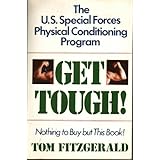
Average Reviews:

(More customer reviews)This book is designed to put the reader through two workout programmes simultaneously. There is a Calisthenics programme, and a Running programme. This is a 12-week cycle; as Fitzgerald says, special forces are always changing and adapting, so there is no 'official' cycle that remains constant forever. Thus, this is flexible here, too. This book is all the reader needs except his own muscles and desire to succeed. No special equipment to buy or anything else. The back cover says this is not for the timid or the lazy. This is like being in the military. No excuses - just do it!
The author is a former Navy frogman named Tom Fitzgerald. He continues his fitness goals by running in the Boston Marathon and other such events. Fitzgerald promises better self-esteem, better motivation, and better accomplishment for those who will complete this programme.
The conditioning programme targets five different body parts with 46 different exercises. The running involves running and rapid walking with some intervals of sprinting. There is also a good deal of stretching involved. If you cannot give this one or two hours a day every day for 12 weeks then maybe this is not the book for you. But one could still get it and look at the exercises that have good descriptions and are useful, even if not following the programme.
Stretching
There is stretching prior to each session. This helps prevent muscle injury and makes one limber. Stretching after also helps healing faster, too.
Diet
This book does not go too much into diet since there are other books ready for that, but it gives some general rules. Vitamins and supplements are discussed and basic common sense like not drinking alcohol or too much sugar or caffeine before a workout. Their advice is humourous: 'If you're looking around for a mate, consider marrying a nutritionist.'
Other general instructions
This section deals with sore muscles, shoe and foot care (very important for the heavy running schedule). Keeping count and keeping at it is important too! At the end of the book is a record for keeping track of progress.
The Stretching Programme
There are 14 stretches in this, and each of them are done both before and after the calisthenics and running programmes. An important note is that this stretching routine was developed at a university training programme and not by the Navy. The chart at the end of the section shows what you should do, including how much time this should take. The opening stretches should take 5 minutes, and the final stretches should take 2 minutes.
The Calisthenics Programme
There are 46 exercises that are done over the course of the week that will exercise ever muscle in your body. There are five main categories.
General Warm-up
There are 10 exercises in the general warm up, and these exercises work to prepare the whole body for work.
Abdominal Exercises
There are 11 exercises in the abdominal section, and they work to strengthen and stretch the abs and your lower back.
The Side and Obliques
There aren't too many exercises in this part -- only 5, but they are important. These are really tough exercises beyond the usual stuff for sides and obliques.
Leg and Groin Exercises
There are 12 exercises in this section and legs are one of the major muscle groups in the body and often get overlooked. People think of abs and arms for fitness, but the legs carry the body weight all day long.
Arm Chest and Shoulder Exercises
There are 8 exercises in this final section for the upper body. The book said no special equipment is needed, but once will need a place to do pull-ups.
At the end of this section is the 12-week chart for how many exercises need to be done. Out of the 46 exercises you will do about half of them each day. Some things like leg stretchers are done almost every day. Some things like the one-legged push-up are done less often.
SEAL training calls running programmes 'conditioning hikes'. These involve running, walking double-time, and sprints in a programme on varying terrain, mostly on sand, which goes from being soft to hard-packed to ridged to in the water, often done in boots. The book makes recommendations for running in boots, and running with ankle weights or other kinds of terrain variations.
The first week involves running two miles in 15 minutes and makes progress up to eight miles at a maximum for the rest of the programme.
The exercises are described in good form each with pictures of each step. All exercises can be done by males or females. The pictures are basic black-and-white and sometimes a little grainy.
One drawback is that this is a tough workout programme from the very beginnin, and some people not be able to tolerate the stress and muscle effort from the outset. A Week Zero or prep conditioning programme would probably be a good idea to add if the book is ever reprinted.
The last part of this book involves setting out the schedule in a good format. There are also pages are for recording a personal record of progress and that can be motivating.
Click Here to see more reviews about: Get Tough: The U.S. Special Forces Physical Conditioning Program

0 comments:
Post a Comment